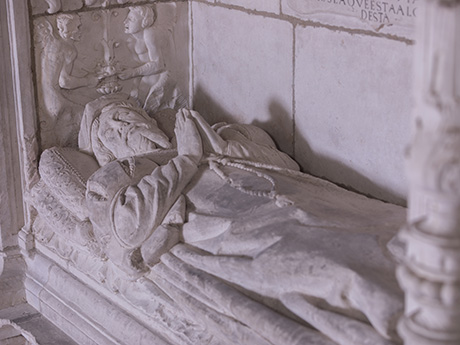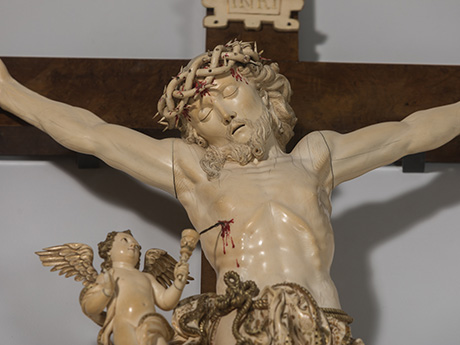Presentation
A Living Treasure
The appearance of the cathedral today is entirely different from how it looked centuries ago, for the building was a place in which image and colour were at the service of liturgical paraphernalia whose sole purpose was to captivate the faithful. Its walls spoke, filled as they were with forms and colours, and accompanied by images and altarpieces, ephemeral structures for special celebrations in addition to tapestries and hangings that covered chapels and altars.
The architectural restoration process currently underway in the cathedral will not manage to recover all the works of movable art that formed part of this ensemble. Only a small number of choice pieces have been selected to partially adorn the building and be able to resume its religious and cultural life. The remaining objects have been safely stored in museums and other institutions.
The restoration master plan that was established back in 1999 already envisaged the recovery and study of its complete collection of furniture. An interdisciplinary project was therefore proposed involving various specialists to inventory, catalogue and assess the state of conservation of this entire heritage. This has helped us to discover many unknown aspects of the movable history of this building and to gradually restore the works most in need, thereby serving to reappraise this rich artistic ensemble.
Our present cathedral has always faithfully reflected the society and history of this city and, consequently, the various social classes of their day have been present in it. Its construction and all its array of artistic items stem from the collective efforts and participation of the whole of society, as well as the faith felt and lived by worshippers. In addition to embellishing and enhancing the magnificence of the church itself, its collection of artworks also possessed a religious, liturgical aspect that sought to convey the message of the Gospel and win over believers. The best example of this can be seen in the magnificent monumental portals that mark the entrances to the cathedral and welcome newcomers. The western portico is one of the great artistic achievements of 14th century monumental sculpture in Spain. Its didactic, doctrinal function aimed to convey religious and social messages to visitors, thereby becoming a transit point between profane and sacred space.
Our present cathedral has always faithfully reflected the society and history of this city and, consequently, the various social classes of their day have been present in it. Its construction and all its array of artistic items stem from the collective efforts and participation of the whole of society, as well as the faith felt and lived by worshippers. In addition to embellishing and enhancing the magnificence of the church itself, its collection of artworks also possessed a religious, liturgical aspect that sought to convey the message of the Gospel and win over believers. The best example of this can be seen in the magnificent monumental portals that mark the entrances to the cathedral and welcome newcomers. The western portico is one of the great artistic achievements of 14th century monumental sculpture in Spain. Its didactic, doctrinal function aimed to convey religious and social messages to visitors, thereby becoming a transit point between profane and sacred space.
Several outstanding stone tombs have survived until today thanks to the presence of these prominent families, such as those of Martín de Salinas; Álvaro Díaz de Esquivel and his wife, Ana Díaz de Salinas; Cristóbal Martínez de Alegría; the Iñiguez de Vasterra family, and the praying figures of Gabriel Ortiz de Caicedo and his wife, Ana de Arana. Also of great interest is the brass funerary tomb lid of Flemish origin for Ortiz de Luyando and his wife, Osana Martínez de Arzamendi.
These private chapels were ostentatious spaces that families used to compete against each other for which had the best, most ornate appearance. This eagerness to be noticed in the society of Vitoria led them to commission major artists to create altarpieces, sculptures, paintings and other liturgical or devotional objects. Although it was also very common for the founders of these chapels or high-ranking family members in important Spanish and foreign cities to send dazzling works from great centres of artistic production. These pieces were both admired and envied, given that families with relatives in commerce, administration, government or the most important military or religious careers were able to acquire them. Once they had achieved success and were firmly established financially and socially, they left traces of this in the city where they were born by making the most of these family chapels or founding others to illustrate their status and that of their families. This facilitated the arrival of imported works of inestimable value that have survived until today and can be found among the cathedral’s most outstanding items.
Some of these exceptional imported pieces include the altarpiece of Flemish origin dedicated to the Sweet Name sent by Juan Alonso de Gámiz, chancellor and chaplain to Charles V. Other outstanding works were also sent to the Holy Christ Chapel by the Galarreta brothers, Secretaries of State and War in Flanders, from where they brought the painting of the Lamentation of Christ attributed to the Flemish painter Gaspar de Crayer, as well as an important reliquary gifted by Claudia de Lira. The leading jurist of the Royal Court of Mexico, Francisco Antonio González de Echávarri, bequeathed to his Saint James Chapel a painting of the Virgin of Guadalupe and an exquisite portable monstrance that was much admired on his arrival in Vitoria. Also from the Americas is an exceptional corn cane Christ that Pedro López de Alday must have acquired in Seville for his Saint Prudentius Chapel. Equally unforgettable are the luxurious sets of Philippine liturgical ornaments sent by Dean Francisco Díaz de Durana that were used for the most important ceremonies. Other exceptional imported works are a devout Virgin of the Rosary of Flemish origin, an image of Little Saint John from the Sevillian school or an outstanding ivory Christ of most likely eastern origin.
This brief summary of the cathedral’s gems cannot ignore the entire collection of furniture in the sacristy, whose restoration has revitalised the 18th-century spirit it had lost after the interventions it underwent throughout the 19th and 20th centuries. It is also impossible to forget the iconic Virgin of Servitude, a Gothic Andra Mari (Virgin Mary) that has since been lost but once presided for centuries over the cathedral’s main altarpiece, continuing to be an image of great devotion for the people of Vitoria. It would be unfair not to mention several pieces of great artistic value, such as the altarpiece painted by the Madrid artist Francisco Solís around the middle of the 17th century, the painting of the Apparition of the Virgin to Saint Benedict from the same period, attributed to the Flemish painter Pedro de Obrel, or the enigmatic Saint Anne with the Child Virgin. There are other exquisitely crafted images by local artists preserved today, such as the carving of the Assumption by the famous “santero of Payueta” Mauricio de Valdivielso that presides over the cathedral, as it has done since the early 19th century.
The portable nature of movable art has meant that it has been more exposed to modifications, or it has been destroyed because of changes in taste and fashions or for other reasons. This cathedral has been no exception, as it has lost countless works of art that lined its walls throughout its long history. Nonetheless, we still preserve a significant artistic treasure that, although it remains scattered because of the restoration work underway, will one day once again adorn this church. Let us hope that this desire can be fulfilled and that the cathedral will recover a major part of its history and personality so that future generations can enjoy them in their entirety and significance.






